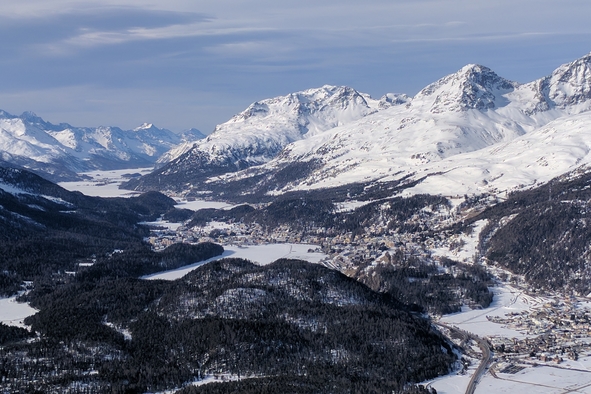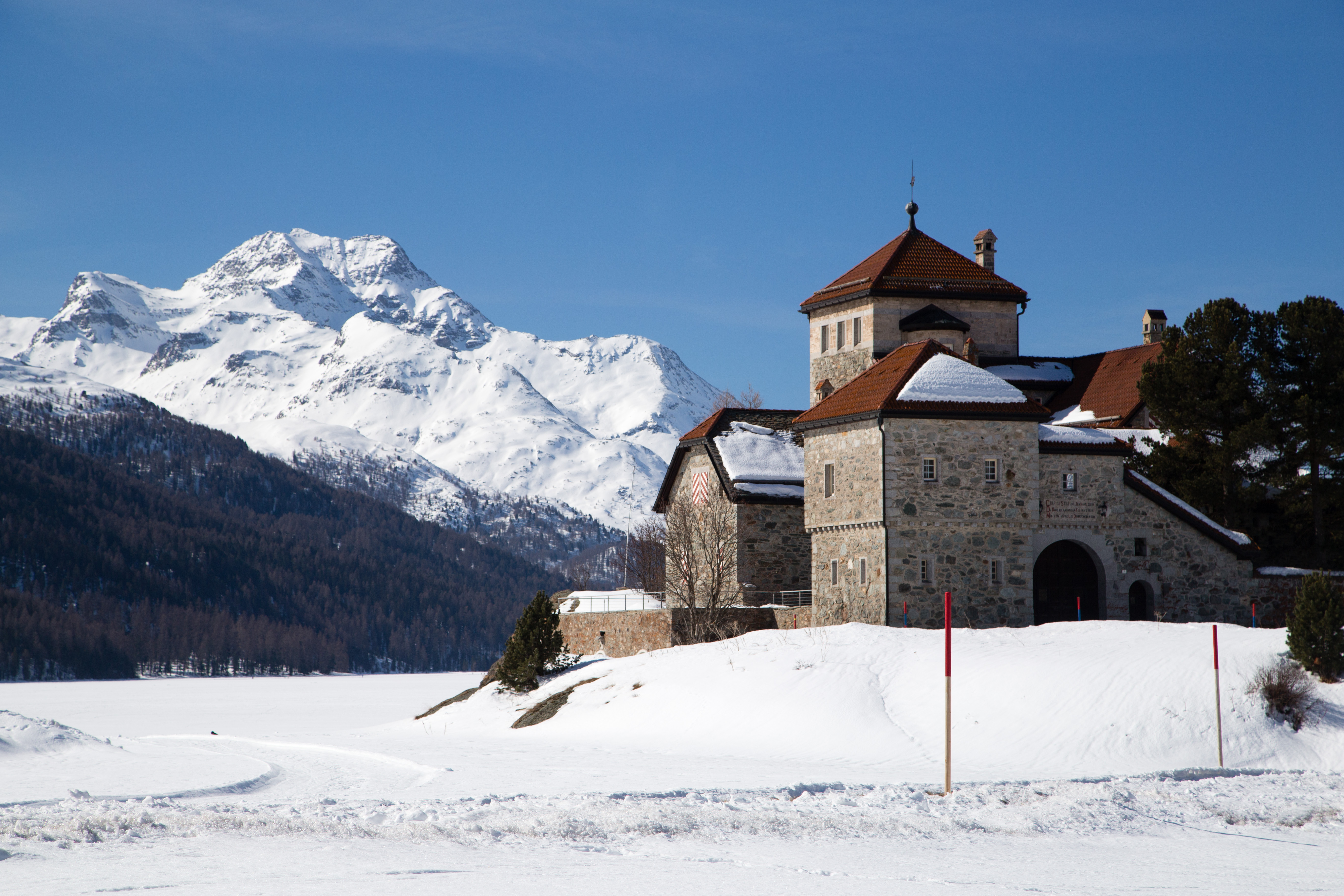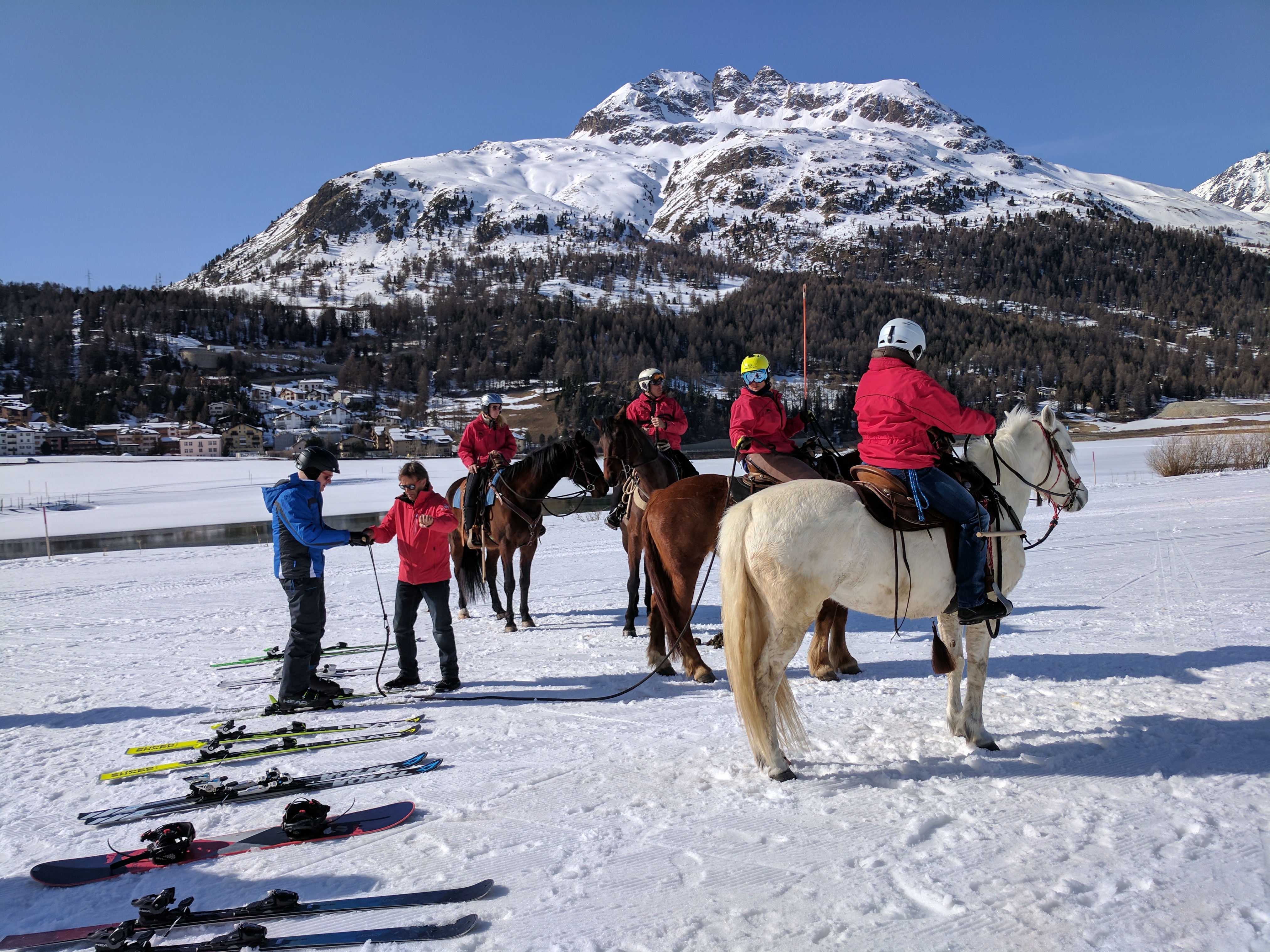The wealth on display in the glitzy Swiss ski resort of St. Moritz, Switzerland, isn’t the limit of the extremes available. Hair-raising sports such as the skeleton – and less well known shenanigans like skijoring – originated from this pioneering enclave, and continue to be ‘enjoyed’ amid the high altitude hedonism.

St. Moritz (Photo: Chris Allsop)
Don’t believe what you hear about St. Moritz. I’d understood the Swiss resort to be a cushy playground for jet-set poseurs unwilling to muss their hair by actually skiing, but now I was standing behind a horse about to ‘skijor’ – a sport invented here, and essentially water-skiing on land with a horse instead of a boat for forward pull.
“Try to steer to the right of the horse,” says my instructor, “to avoid any collisions.” He makes a face. The horse whinnies, the rope jerks, and we’re away. Midday drinkers encamped at the nearby pop-up bar rouse themselves to enjoy the sport.
This horsing around is de rigeur in St. Moritz, where the sport of skeleton grew out of testosterone-charged Brits riding tea trays down the town’s frozen lanes. It’s actually the original Alpine winter resort, a concept seeded in 1864 when hipster-bearded pioneering hotelier Johannes Badrutt made a bet with his aristo English guests departing at the end of the summer season. “Return at Christmas and stay until Easter,” he reportedly said. “If you don’t find St. Moritz as sunny in winter as it is in summer, I’ll pay your travel costs and put you up.”
The valley’s abundance of sunny days has, ever since, featured prominently in St. Moritz’s brand identity; indeed, the resort’s logo, hung liberally around its hilly streets, is of a beneficent beaming sun, and wouldn’t look out of place on a Greek islands ferry company letterhead. Add Swiss landscape perfection to the formula, and you see that canny Badrutt knew that the only person making bank all those winters ago would be him.

Living large in the Upper Engadine Valley (Photo: Chris Allsop)
Upper Class
Positioned in the Upper Engadine valley at a breathless altitude of 1,856m, the resort of St. Moritz comprises three villages – St. Moritz-Dorf, St. Moritz-Bad, and Celerina – positioned around Lake St. Moritz – one of a series of small bodies of water enchained between the broad peaks. The frozen lake isn’t only a focal point for the panoramic windows of the best hotel rooms: since 1906, it’s been the site for a series of sports events that have cemented St. Moritz’s upper class appeal. The most prominent of these is White Turf – an annual horse race, set over three weekends in February, that involves having the animals fitted with specially spiked horseshoes to allow them to charge over the lake ice. The be-furred jet-set sink oysters and champagne flutes in the sub-zero conditions, while enjoying a flutter on the various disciplines (this includes skijoring at terrifying speeds behind unsaddled thoroughbreds).
While it’s fair to say that plenty of visitors to St. Moritz do take to the slopes, the resort’s reputation as a high-altitude people-watching paradise is well deserved. Its appeal to the very wealthy has its roots in those first English toffs lured back by Badrutt’s bet. More of the British upper classes followed, and in their wake came European royalty – Kaiser Wilhelm II, Tsar Nicholas II– followed by celebrities such as Brigitte Bardot, Gunther Sachs (who founded the infamous St. Moritz nightclub, Dracula) and Charlie Chaplin, the latter reportedly the first man to drive a car to St. Moritz in the winter. Today it’s particularly popular with Russians, John Travolta, and Prince Harry.

Lavish desserts as standard (Photo: Chris Allsop)
But back to the skiing. The pistes of St. Moritz, best suited to intermediates (and the site of Switzerland’s first ski school in 1929), have twice hosted the Winter Olympics, and the Alpine Ski World Championships no fewer than five times, including in 2017. But typically the winter sport that most associate with St. Moritz is the skeleton, as the resort is the home of the grand and occasionally lethal Cresta Run – the world’s only natural ice skeleton track on which racers reach speeds of up to 87 mph, their noses literal inches from the unforgiving course.
Traditions to Die For?
If you survive, it’s the tradition of the St. Moritz Tobogganing Club to enjoy schnapps and cigars at the Sunny Bar afterwards, located in the lower levels of the Kulm Hotel. The five-star Kulm, where I’m fortunate enough to be nursing my bumps and bruises during my sojourn in the Alps, was the first hotel to be built in St. Moritz (then a pension called the Faller) and owned, naturally enough, by Badrutt (now it belongs, like much of the valley, to the Niarchos family, after shipping magnate Stavros Niarchos, in 1968, swooped in to save the hotel being purchased by – horror of horrors – Club Med).

Getting ready to skijor/faceplant (Photo: Chris Allsop)
It’s through the hotel that I’ve arranged my skijoring experience, but I almost immediately have second thoughts after feeling the powerful acceleration offered by what is essentially a large-ish Shetland pony (as it’s my first time, I plumped for what I assumed was the beginner’s horse). Cutting through the snow, I attempt, as advised, to execute small turns to check my speed. When we come to the first 180° turn, it’s more luck than judgement that I manage to stay vertical; apparently water-ski or wake-board experience does come in handy for skijoring. Alas, when it’s time for the crucial – and very public – 180 in front of the bar, and to a chorus of encouraging shouts from my fellow skijor newbies, I stack it with a tremendous faceplant. The cheering fades.
Some of my skijor group are more successful, while others, particularly one participant who ended up on crutches, are not. Naturally, after the success of the skijoring, the Cresta beckoned, but I met the challenge halfway by going tobogganing instead. Muottas Muragl, sounding more like a doomed pass from The Lord of the Rings than a fun run, offers 20 corners on a winding 4.2 km track that drops 718 metres with panoramic views of the Upper Engadine all the way. As it turned out, the only easy option in St. Moritz is the people-watching.